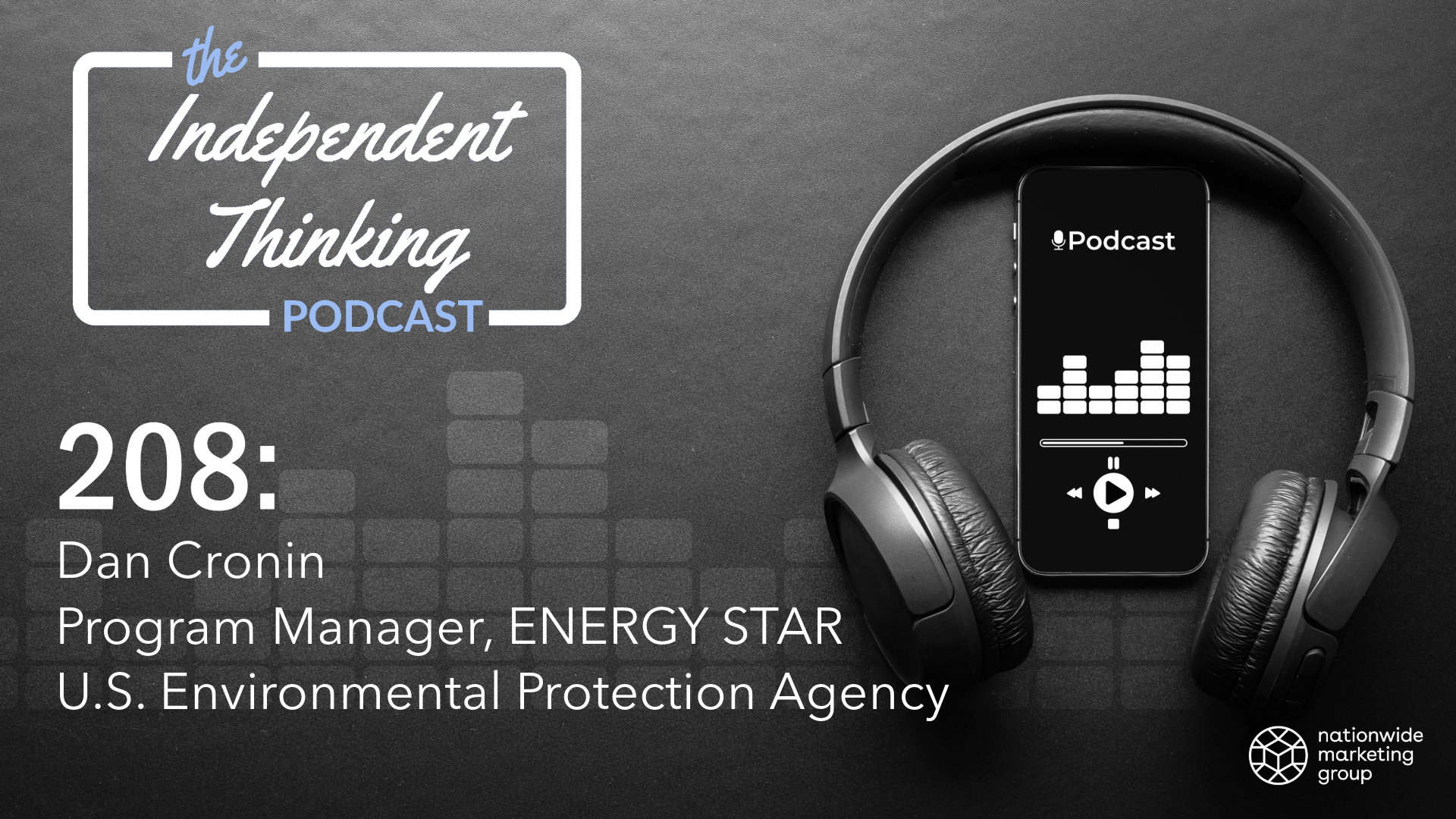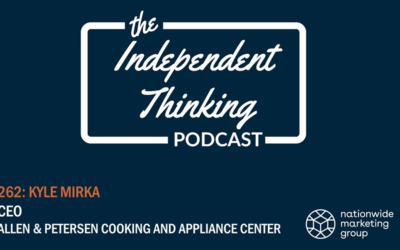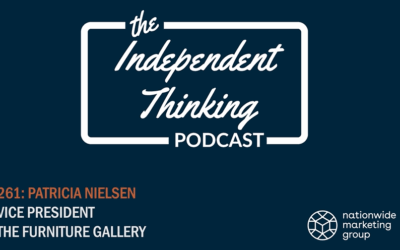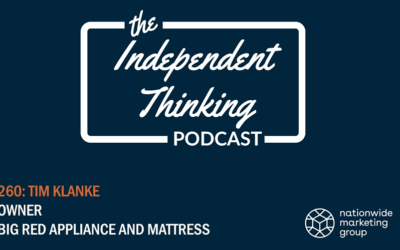While with us in Las Vegas for his first experience at a PrimeTime event, U.S. Environmental Protection Agency Program Manager Dan Cronin sat down for a podcast. Cronin recounted his experience at the show, talked about the just announced Partner of the Year Awards (of which, NMG was an honoree) and much more.
Here is the link to the ENERGY STAR Rebate Finder tool that was referenced during the episode.
Rob Stott: All right, we are back on the Independent Thinking Podcast coming to you from Primetime out here in Las Vegas. And we’ve done a podcast before, but doesn’t it feel different to do it in person?
Dan Cronin: It’s much different.
Rob Stott: Mr. Dan Cronin, a program manager there at the US Environmental Protection Agency, specifically ENERGY STAR program.
Rob Stott: Thank you for joining us. Thank you for coming, man.
Dan Cronin: Yeah, thank you for inviting me.
Rob Stott: That’s all Caleb, right?
Dan Cronin: Yeah, Caleb and Frank, they invited me. They’ve been inviting me, actually, but this is the first time that I can make it work actually for a very long time.
Rob Stott: That’s awesome.
Dan Cronin: But yeah, you guys are a great partner for ENERGY STAR and it actually has given me a deeper appreciation for everything that you guys do as the whole nexus of the manufacturers and the members and all that. Plus, your market share collectively is quite large and so you guys do move markets. Yeah, it’s been definitely eye-opening and I appreciate what you all do.
Rob Stott: Yeah, I want to start there because your great overview of your impressions of the show. So as you’re here, knowing that you were coming, how did you prepare for Primetime or what did you want to try to accomplish while you were here with us?
Dan Cronin: Well, specifically I definitely wanted to connect with some of the manufacturers who are here. Some of the folks that I interact with were going to be here and I did get a chance to chat with them. There are several partner of the year winners here as well, along with Nationwide itself. So seeing how they’re marketing their products, how they’re using the ENERGY STAR out in the field and what they’re talking about, it’s not a one-size-fits-all approach. Everyone takes it and uses it in the way that they see best and I love that. I think that’s great, that people are taking ENERGY STAR and using it in a creative way.
Rob Stott: No, that’s awesome. So we could talk about it, right? We’re sitting here on camera. It’s a little bit before, but as we’re dropping this episode and it’s going live, partner of the year. We will dive right in, so partner of the year gets announced around this time every year and 10 years of sustained excellence for Nationwide. So talk about that program, to be involved with it, I know a lot of our winners, our co-winners the last couple of years here with us as well. So you mentioned being able to see them as a unique opportunity last year at Primetime, it lined up so perfectly we were able to present some awards to them on behalf of Nationwide and ENERGY STAR. But that program for those not familiar with it, the partner of the year program. Talk about that a little bit.
Dan Cronin: Sure. So the partner of the year program extends to all of our partners. And it’s not just for products or retailers, it’s also for commercial building owners as well as new home builders because ENERGY STAR covers all of those things, not just products. So I would say about somewhere between 1% and 2% of our total partners win partner of the year. And so the fact that you have won for 10 years and then I think a total of 20 years.
Rob Stott: Yeah, I forget.
Dan Cronin: Somewhere in that range.
Rob Stott: You may know better than me, I think, but the sustained excellence starts after a certain point?
Dan Cronin: After three years. On your third consecutive win, you are a sustained excellence partner.
Rob Stott: Fantastic.
Dan Cronin: And so what Nationwide has done is build ENERGY STAR into the DNA of your offerings to your members. And that’s what we’re always hoping for because the ENERGY STAR conveys quality, it conveys efficiency, dollar savings. When a consumer sees that little blue logo, that’s what they associate it with. And so yeah, it’s a way to build a bridge between someone who may not know exactly what they want, but they see that little blue logo and they want it. They want it in their home. And so it’s a partnership program, ENERGY STAR. And I think this is the truest sense of partnership because we’re EPA. We can create all the marketing materials we want, we can create all the technical specifications that we want, but until a partner actually takes it and puts it out into the world, does a tree falling in the forest make a sound of no one’s there around? I think that’s the difference. So without you guys really hammering the energy savings message, we could only go so far. So we appreciate it.
Rob Stott: No, it’s awesome. And for us, maybe it’s because we’ve been doing it for so long that it makes sense to us, but it’s one that, we were talking before, the retailer needs to continue to hear and learn about. So for those that might not know, let’s rewind a little bit. The overview on ENERGY STAR and the importance of it within this channel, obviously it’s got broader reach, as you mentioned. A lot of categories it touches, but to retailers, what’s the importance of this program?
Dan Cronin: Yeah. Well, I mean, ENERGY STAR started with one product category, which was computers back in 1992. And now there’s over 75 product categories, so it runs the gamut of what we cover. Everything from any HVAC product in your home, any water heating product in your home, electronics and of course appliances, which a lot of your members sell. And that extends to clothing as well as kitchen. And the way we do it, I don’t want to get too far into the details, but whenever there’s a differentiation opportunity, whenever there’s a more efficient product in a given category, that’s an opportunity to us. We want to capture that and point people or just let people know, let consumers know that an efficient option exists out in the world. It’s a purely voluntary program, so manufacturers choose to have their product tested and then certified.
And then in return, in some cases, there are a lot of rebates available from utilities that are able to subsidize the cost of a brand new ENERGY STAR product and those are Nationwide. So that has kind of been the engine for the success and the growth of at least the products. I work on the product side and so it’s been successful. We’re always looking for new products as well, so one of our newest products is electric cooking. That is both induction as well as coil and that also includes portable models.
Rob Stott: Okay. Wow.
Dan Cronin: Yeah, so that’s really exciting for us because there are a lot of benefits to electric cooking that are not just energy savings, but there are health benefits and safety benefits, especially with induction. And I’m walking around here at the show, there seems to be from the manufacturer’s standpoint a lot of emphasis on induction, but electric as well. And so it seems like everyone kind of gets that this is going to be a part of the future or a bigger part of the future than it has been.
Rob Stott: Right. And it kind of goes back to as well that you mentioned the partnership, right? Obviously Nationwide EPA, but as well the manufacturers and Nationwide. You mentioned the federal. We were talking also earlier the federal triangle. It feels like that’s what it is between the manufacturer and EPA and Nationwide to be able to work … Well, we’ll call it the federal square. How about that? Because then there’s the retailers involved in this as well. Making that partnership happen. They are the retailer. They are a quarter of that square that I’m referencing, but how can they leverage those other three corners?
Dan Cronin: Yeah. I mean, now by the other three corners, you mean the products or …
Rob Stott: All of it?
Dan Cronin: All of it. Okay.
Rob Stott: So products, Nationwide, EPA, what’s available there to them that they can …
Dan Cronin: In terms of co-marketing materials?
Rob Stott: Yeah, absolutely.
Dan Cronin: So we come out with lots of co-marketing materials for free that any of your members can take and use. I believe that you all make this available to your members as well, but yeah. If you’re a member of Nationwide, you’re technically a member of ours because you’re part of that group. And if you’re selling ENERGY STAR products, you should put that front and center as an option for consumers coming in because it does convey quality and energy savings. And if you’re not currently, if you’re running a store right now and you’re not currently thinking about how can I get rebates in my store to drive down that point at the point of sale, drive down the cost of the point of sale, you should be because on our website we have a rebate finder, for instance. Google ENERGY STAR rebate finder and we have Nationwide rebates that are updated for the entire country for all of our products. And people find a lot of value in that.
Rob Stott: Yeah, absolutely. And you mentioned the tools. I can personally vouch because I know around you guys, obviously there’s the partner of the year stuff that’s coming up that will be happening as this episode drops. There’s Earth Day. The toolkits that you have available, we lean into them frequently on our side to be able to get assets that help promote that message and co-branding opportunities within them, right?
Dan Cronin: Exactly. Yeah, Earth Day is a big one. ENERGY STAR Day later in the year is a big one. That’s usually in October, but for individual product categories as well we have co-marketing materials. If you just want to do refrigerators, we have free co-marketing materials that you can take and run with, put your logo on it, put it in your store, put it on your social media if you’re doing that. And yeah, it drives interest. It peaks consumer’s interest and brings them in.
Rob Stott: Now, I know I love data. I don’t know if you have any off the top of your head that you could pull, but consumers that see this mark, you guys, are you aware of the impact that it has on their purchase decision?
Dan Cronin: Yeah. I mean, I could talk broadly about public data that has been produced with us or for us. So about 90% of Americans recognize the label and that’s the key thing.
Rob Stott: That’s important.
Dan Cronin: Right. They understand generally what it is at a basic level and that’s good. Hopefully that if I’m doing my job, maybe it’ll be 91%, 92% next year. Who knows? So that’s one important thing, but then in some other cases manufacturers or retailers or utilities will spend their own budget to actually do A-B testing to see what is the impact on consumers or in a survey what is the impression of the same product with or without the ENERGY STAR. And repeatedly, it always comes back that people prefer the thing with the little blue logo on it and that speaks to the value. That just speaks to the value proposition. And in a lot of cases, it’s not easy for the manufacturers to meet the requirements.
For instance, televisions is one of our oldest product categories. I think we’re on version nine of our TV specification and we just basically had a reset because periodically we have to increase the stringency of our technical requirements for all of our product categories. We don’t want ubiquity. We don’t want everything on the shelf to be ENERGY STAR. That does a disservice to us and to the brand and to the manufacturers. So generally speaking, we want the top 25% of energy performance. But how do you do that? You work with the manufacturers, you work with the stakeholders in an open process to propose higher levels of performance and then meet kind of in the middle. Finalize that and then your product list basically goes down to practically zero, which is kind of what happened to TVs last summer, I want to say. So we had somewhere around 70% market share, which is too high.
And so we said we needed to refresh this, so we did. And the new specification, there’s about 1% or 2% market share now, but it’s an opportunity because the manufacturers who are going out of their way to meet this more stringent bar, leap over that bar, those TVs are really efficient. I think the new TV spec on average, depending on the size of the TV, they’re 34% more efficient than a non-ENERGY STAR TV. And it’s becoming more important, actually, because more TVs are getting smarter. They have more components, they have more chips in them. They’re becoming almost like the smart home hub in some cases, so it’s important that the energy efficiency of each product, each TV reflects the real world usage. And so that’s what we did.
Rob Stott: Well, the cool thing about that, too, is it shows these aren’t just set it and forget it standards. You guys are constantly as an agency looking at these products, evaluating them, putting them through what I have to imagine are some pretty stringent and …
Dan Cronin: Contentious.
Rob Stott: Right.
Dan Cronin: Contentious at times, yes.
Rob Stott: Just to ensure that it’s meeting the level of requirement that you guys expect to be able to earn this mark.
Dan Cronin: Precisely.
Rob Stott: And it’s cool to watch because as fast as the technology evolves, that also goes to show how fast those standards have to evolve.
Dan Cronin: Exactly. And if we weren’t doing that, if we weren’t always pushing the bar upwards and there will never be a stopping moment for it, then it would be a disservice because our whole goal is to save people money, mitigate climate change, convey quality in the product that you’re buying with the little blue logo. And so it has to be a little hard to meet. If it’s easy, it doesn’t mean too much, right?
Rob Stott: Amen. So I want to go back to something you mentioned a little earlier, which was rebates. And I know that’s a lot. If anyone’s been paying attention, especially here at this show, they’ve seen Mr. Santner on stage talking about the Inflation Reduction Act. And I know that’s a big point of emphasis right now within Nationwide to educate around everything going on there. I know Frank. He’s been the phone. I don’t even know, I don’t want to know, how many times or on how many calls try to be that voice for the independent channel, having a seat at the table among the discussions for all the rebate calculators and things like that that are being developed for this program. So talk about that, a little update on that. Where do things stand right now with the Inflation Reduction Act?
Dan Cronin: Sure. Okay, IRA?
Rob Stott: Yeah.
Dan Cronin: Yeah, so Inflation Reduction Act is signed into law in 2022. And as part of that program, I would be remiss if I didn’t mention the tax credit side because a really big part of it. But it is a little bit less relevant to your members, but it’s worth just mentioning. So the most energy consuming products in your home are essentially found their way into the tax credits. So things like heat pump water heaters, heat pumps for HVAC that can heat and cool your whole home, things like windows, attic insulation. And if you are going to make all these upgrades, you might have an older home that needs to upgrade its electricity panel. So that, an upgrade to the electricity panel, is also one of the tax credits. So all of those things are available to Americans now and I think that goes through 2031. So that’s the tax credit side and that’s baked into the cake, but also what was authorized in that law was a series of rebate programs that will distribute money to all the 50 states to subsidize the cost of various different products.
Some of which are ENERGY STAR products. I think we’re the center of the Venn diagram of the nationwide members and all the rebates. And there’s a lot left up in the air. We are not in the driver’s seat there. We’re monitoring that, but the Department of Energy is implementing that. Products like heat pump clothes dryers and the electric cooking, which I mentioned earlier, those are eligible products, but each state would have to apply for that product to the Department of Energy and say, “Hey, holding our hand up. We want this product or that product in our program.” So it’s eligible, but the states will have to apply for that money specifically for that product.
Rob Stott: Which is ongoing, right?
Dan Cronin: It’s ongoing.
Rob Stott: There have been applications?
Dan Cronin: Yes.
Rob Stott: I think last I checked, and this was maybe January last time I spoke with Frank on this, I think there were four states that had gone through some and had approvals.
Dan Cronin: I don’t know about approvals, but they’ve applied.
Rob Stott: Or their applications have been submitted?
Dan Cronin: Yeah, so it’s California. This is all public information.
Rob Stott: New York.
Dan Cronin: New York, California, New Mexico and Hawaii have applied. And so we’ll see the structure of their applications. I don’t have any view into that. It will be interesting to see how that will ultimately filter out there because I know a lot of your members carry those products. Some of them are a little niche. I mean, electric cooking, that’s pretty ubiquitous, though. I mean, a lot of your members sell that already. Part of the principle is that renewable electricity generation is becoming much more common in America. I think Texas has the number one wind production in the country right now, if I’m not mistaken. I could be wrong about this. I think California might have the most solar. So there’s renewable generation happening during the day and at night and there’s got to be a way to use it. And you definitely don’t want to waste it, especially because it’s taking market share. And so electric cooking helps with that a little bit because it’s a way to cook your food with the available renewable energy and it’s the only way to do that. So that’s part of it.
And as I mentioned before, there are other health benefits and safety benefits for induction specifically. So yeah, the other product is heat pump clothes dryers. I love that product category. Anytime you put a heat pump into a product that’s electric that didn’t have a heat pump previously, you see the efficiency skyrocket. It’s amazing what a compressor can do.
Rob Stott: Yeah, it’s crazy.
Dan Cronin: So that’s going to be exciting. Many of the ENERGY STAR heat pump clothes dryers, it has to be a heat pump clothes dryer, theoretically could be eligible in those rebate programs if the state applies for that. And the Department of Energy, they have a list of FAQs on their website that also clarified that the all-in-one washer heat pump dryer that several of the manufacturers here make, I’m pretty sure they’re ENERGY STAR products already. I think they’re already certified. Because they have a heat pump element, they are also going to be eligible for that as well. So that is great because people already love that product and it’s a space saver. It’s a time saver because if you dig into … I haven’t verified this, but I think you know where I’m going with this.
Rob Stott: I do.
Dan Cronin: But the amount of time that wet clothes stay …
Rob Stott: Rewashed? I can tell you it happens at least twice a week in my house.
Dan Cronin: So after I heard this statistic, I actually paid more attention to the way I wash and dry my clothes. But the way that you wash your clothes, you leave them in the washer with them just sitting there for an hour. I think they stay in there for the average is an hour, which is not great. Don’t you want to wash it and then have the dry cycle click on and then in two hours it’s all done?
Rob Stott: The fact of not even having to pick them up, pick the wet clothes up out of the washer and put them in there, that sounds fantastic to me. So it’s incredible.
Dan Cronin: Yeah, and they’re pretty big drums, too, so they fit a lot of clothes. So yeah, so there’s a lot going on. It’s an exciting time for ENERGY STAR broadly, I think.
Rob Stott: Yeah, and you’ve mentioned the tools, too, like the rebate finder as well. So you guys are making this, on the ENERGY STAR side, simpler for consumer and retailer. I have to imagine being able to dive into this tool, see what’s available in their area that they should be prepared for, prepared to process and all that sort of stuff as well.
Dan Cronin: And it’s not just the usual suspects people think, like it’s this amount of money for only your refrigerator or a light bulb or something like that. I was looking the other day and it really runs the gamut of all of our products, things like dehumidifiers and root air cleaners. Various different utilities have different approaches for how they want to run their utility rebate program and a lot of our products happen to find their way in there. So yeah, the one-stop shop for all the rebates are just Google ENERGY STAR rebate finder and you can get …
Rob Stott: Might even put a link to it in the description there.
Dan Cronin: There you go.
Rob Stott: You don’t even have to Google anything. Just look down below. No, that’s awesome, man. Well, this was a ton of fun. And I know you had to walk five steps to get here.
Dan Cronin: I did, yes.
Rob Stott: And your strides are even shorter because how tall you are, but for me it’s like 10 steps over there. But no, this was a lot of fun to be able to do in person out from behind our Zoom cameras. But no, this was great. And I’m sure on behalf of Frank and Caleb, excited to have you here and get back out there, see what’s going on. And keep pumping that ENERGY STAR message. We’ll be doing the same and hope you enjoy the rest of your time here.
Dan Cronin: Thank you. Likewise.
Rob Stott: Okay.





